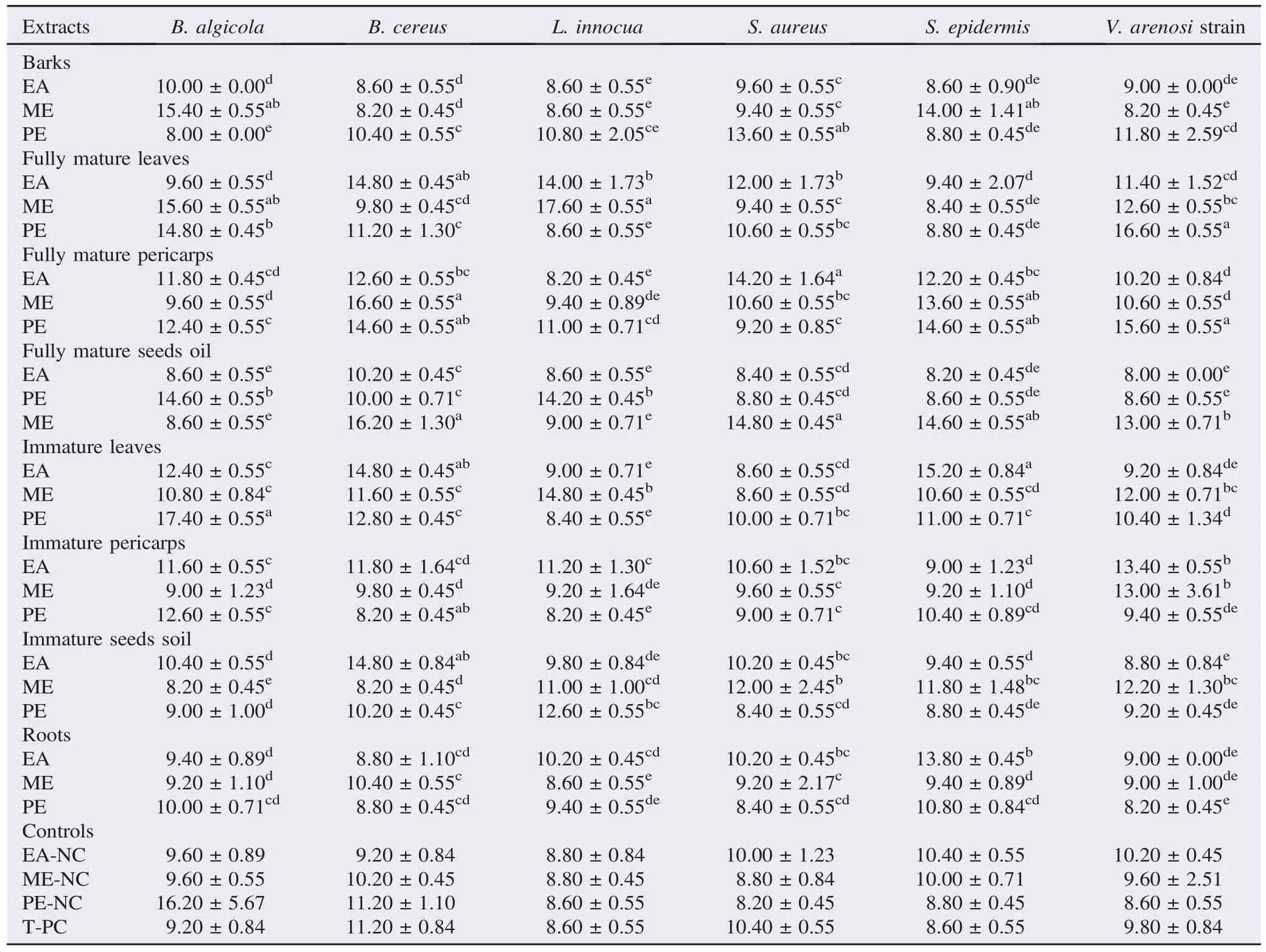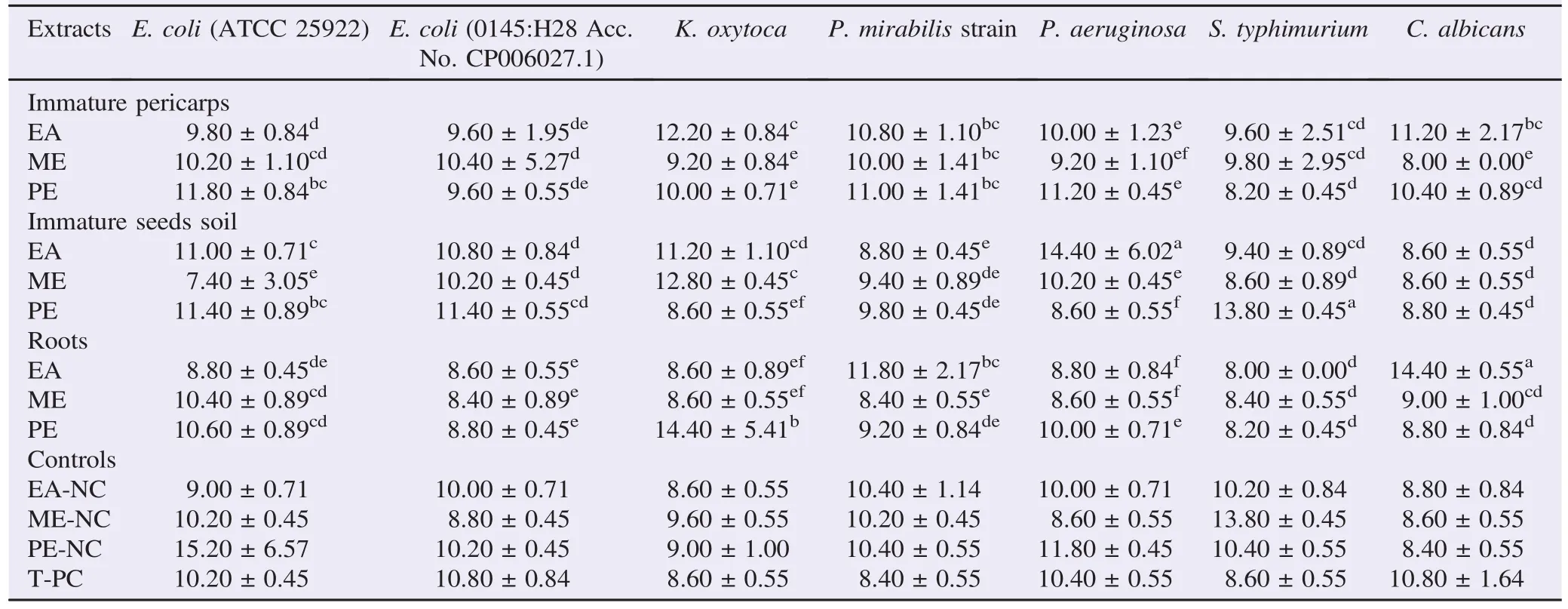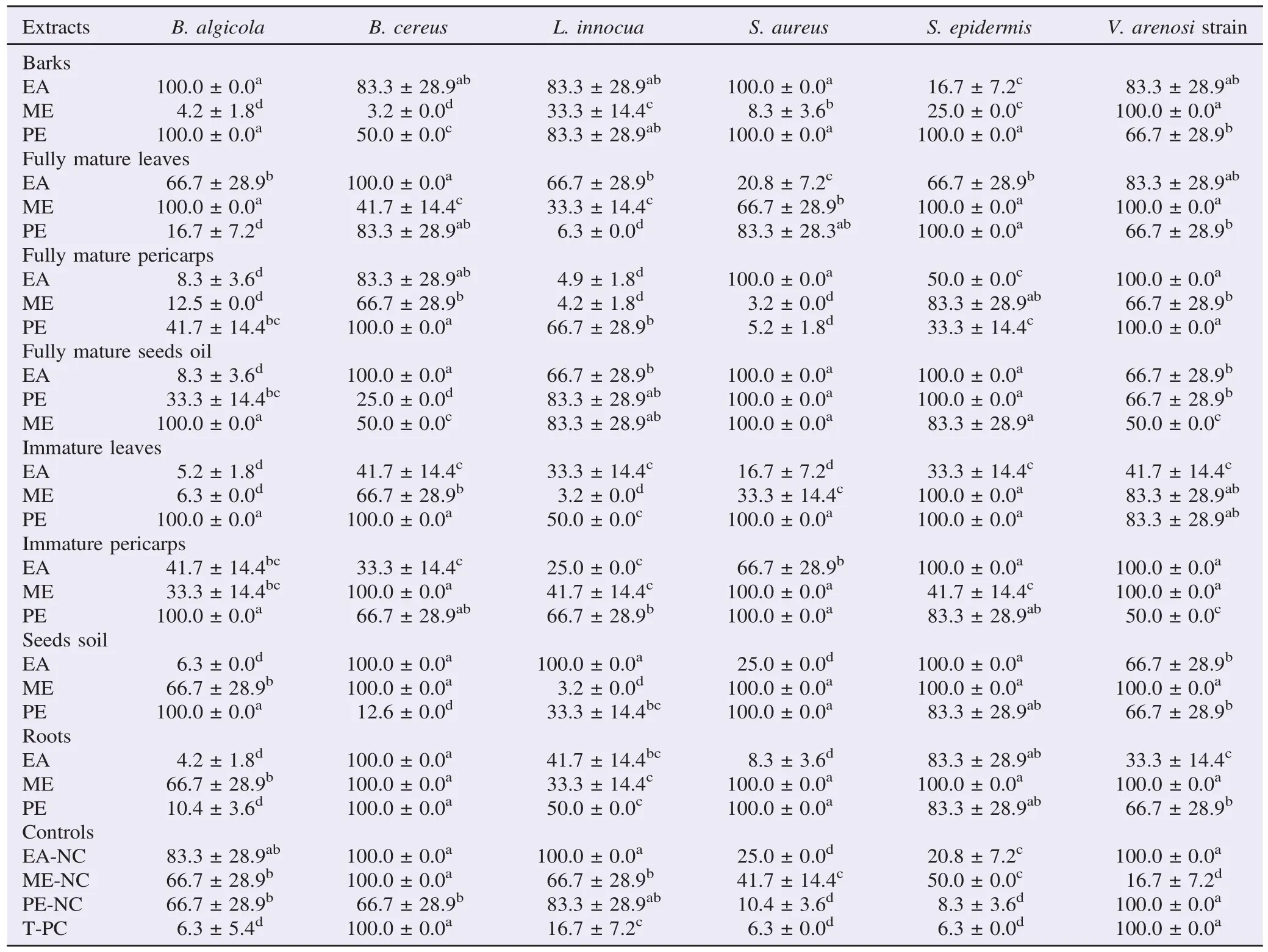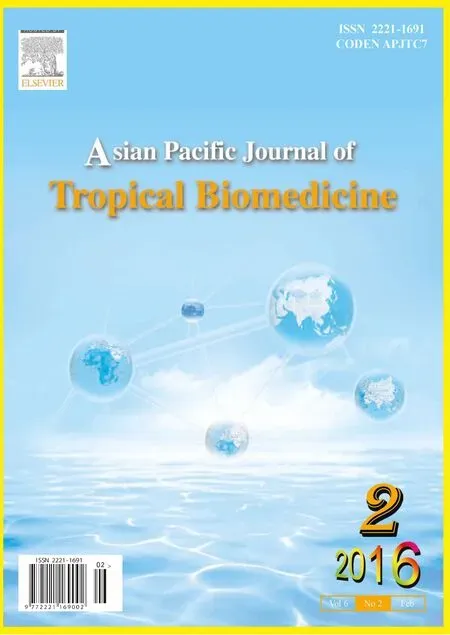In vitro antimicrobial and larvicidal properties of wild Ricinus communis L. in Mauritius
Sillma Rampadarath, Daneshwar PuchooaFaculty of Agriculture, University of Mauritius, R′eduit, Mauritius
?
In vitro antimicrobial and larvicidal properties of wild Ricinus communis L. in Mauritius
Sillma Rampadarath, Daneshwar Puchooa*
Faculty of Agriculture, University of Mauritius, R′eduit, Mauritius
Original article http://dx.doi.org/10.1016/j.apjtb.2015.10.011
Tel: +230 4037400
Fax: +230 4655743
E-mail: sudeshp@uom.mu
Peer review under responsibility of Hainan Medical University. The journal implements double-blind peer review practiced by specially invited international editorial board members.
Foundation Project: Supported by University of Mauritius (Grant No. Q0085).
2221-1691/Copyright?2016 Hainan Medical University. Production and hosting by Elsevier B.V. This is an open access article under the CC BY-NC-ND license (http:// creativecommons.org/licenses/by-nc-nd/4.0/).
ARTICLE INFO
Article history:
Received 11 Sep 2015
Receivedinrevisedform21 Sep2015
Accepted 23 Oct 2015
Available online 18 Dec 2015
Keywords:
Antibacterial activity
Larvicidal property
Minimum inhibition
Ricinus communis
ABSTRACT
Objective: To explore the phytochemical and antimicrobial activities as well as the insecticidal properties of the different sections of Ricinus communis (castor) plant in Mauritius.
Methods: Qualitative and quantitative methods were used for the determination of phytochemicals in the crude leaves, pericarp, seeds, bark and root extracts obtained by using polar and non-polar solvents. The disc diffusion and micro-dilution methods were used to evaluate the antimicrobial activities of the crude solvent extracts against 13 microorganisms. The insecticidal properties of the crude extracts on larvae of Bactrocera zonata (Diptera: Tephritidae), which caused important economic losses to local fruits were also investigated.
Results: All the extracts from the different parts of the plant showed antimicrobial activity against most tested microorganisms. The polar solvents' extracts of the fully mature parts of the castor plant were active against the Pseudomonas aeruginosa (ATCC 27853), Escherichia coli (E. coli) (ATCC 25922), E. coli (0145:H28 Acc. No. CP006027.1) with inhibition zones ranging from 16 mm to 19 mm and against Bacillus cereus (ATCC 11778) (B. cereus), Listeria innocua (ATCC 33090) (L. innocua). Lowest microbial inhibitory concentration was recorded for B. cereus, L. innocua, Staphylococcus aureus (ATCC 29213), E. coli (ATCC 25922) and Proteus mirabilis strain (NCTC 11938) with value of 3.2 μg/mL. The most active extract against both Gram-negative and Grampositive bacteria was extracted from the fully mature pericarps and it was the most active against E. coli (ATCC 25922), B. cereus, L. innocua and Staphylococcus aureus (ATCC 29213). In addition, the extracts obtained by using polar solvent and fully mature leaves demonstrated the strongest larvicidal activity against Bactrocera zonata (100%).
Conclusions: Ricinus communis (castor) plant extracts possess larvicidal properties providing an effective eco-friendly control for fruit flies. The antimicrobial results justify the use of this plant in traditional medicine and the practice of supplementing decoctions/ concoctions with conventional antibiotics.
1. Introduction
Plants contain a wide variety of active compounds that exhibit antimicrobial and larvicidal activities. In addition, due to the fairly recent surge in the antibiotic resistance of pathogenic microorganisms and increasing consumer concerns regarding the negative health impact of synthetic preservative, there has been a dramatic increase in the application of natural antimicrobials of plant origin [1]. Besides the antibacterial, antifungal and anti-inflammatory activities, many essential oils and plant extracts have shown to possess antioxidant, anticancer, anticonceptive, antiphlogistic and antiviral activities [2].
The efficiency of the essential oils and plants extracts depends on its chemical composition which itself depends on the genotype of the plants as well as on the environmental and agronomic conditions. The presence of natural products such as terpenes, alkaloids,flavonoids, coumarins and other secondarymetabolites support the popular uses of these plants in medicines and integrated pest management projects. Essential oils are composed of mixtures of volatile secondary metabolites commonly concentrated in different plant organs [3].
Many tropical and subtropical plants have shown to possess larvicidal and antimicrobial activities. Several research works have also established the larvicidal potential of plant extracts and essential oils obtained from different parts of a variety of plants against larvae of Diptera. The insecticidal effects of plant chemicals vary not only according to plant species, mosquito species and plant parts, but also to extraction methods used in experiment [4].
The castor bean plant, Ricinus communis L. (Malpighiales: Euphorbiaceae) (R. communis), is grown extensively throughout tropical regions of the world with wide applications in industry and agriculture. It is an important oilseed crop that produces oil rich in ricinoleic acid. The various solvent extractions prepared from the different parts of the plant have been reported to possess medicinal properties viz., hepatoprotective, anti-diabetic, laxative, anti-fertility, antimicrobial, analgesic, antihistaminic and anti-inflammatory[5]. Castor plants grow widely in Mauritius and this work was undertaken to evaluate the plant's dual bio-efficacy effects, namely, antimicrobial and larvicidal activities.
2. Materials and methods
2.1. Collection and identification of plant materials and other materials
Immature parts (leaves, pericarp and seeds), fully mature parts (leaves, pericarp and seeds), barks and roots of R. communis (Acc No: MAU 26488) were collected for this research work. The taxonomic identity of the collected sample was authenticated by the Herbarium, Ministry of Agro-Industry and Food Security (Mauritius). The analytical reagent grade solvents used for extraction, Whatman filter papers and sterile Petri dishes were purchased from Sigma Chemicals?; whereas the media and standard antibiotics, and microplates were obtained from Oxoid?and Merck?.
2.2. Metabolite and oil extraction
The collected plant parts were thoroughly washed under running tap water and then dried in shade. After that the plant crude extracts were obtained by using decoction method. The different plant parts (20 g) were macerated in 40 mL of either ethyl acetate (EA, moderately polar), methanol (ME, moderately polar) or petroleum ether (PE, non-polar) solvent systems for 48 h. The filtered (Whatman filter paper, pore size 15–18 μm) crude extracts were concentrated in a ventilated fume cupboard at room temperature and then stored at 4°C in dark bottles. Castor seeds oil was extracted from finely ground seed powder by using the Soxhlet distillation method and the oil extracts from the three different solvent systems were stored at 4°C until further use.
2.3. Qualitative phytochemical screening
The screening of flavonoids, alkaloids, saponins, steroids, tannins, coumarins and phenols was carried out according to methods based on a series of test tube tests.
2.4. Larvicidal assay
Three-day-old larvae of Bactrocera zonata (B. zonata) were obtained from the Entomology Division of the Ministry of Agro-Industry and Food Security. The crude extracts from different plant parts using petroleum, methanol and ethyl acetate were tested for their effects on the larvae by spraying the natural food formulation with three different concentrations [0.2, 0.4 and 0.8 mg/L (w/v)] of crude and oil plant extracts. The experiment was set in a completely randomised manner with 3 replicates of 20 larvae per treatment (food with extracts) and time and controls (food without extracts, and the three solvents) in sterile Petri dishes (9 cm diameter) and the numbers of larvae death were observed after 24, 48 and 72 h incubation period.
2.5. Antimicrobial assays
Subcultures of six Gram-positive bacteria Bacillus algicola (Acc. No. 13/5) (B. algicola), Bacillus cereus (ATCC 11778) (B. cereus), Listeria innocua (ATCC 33090) (L. innocua), Staphylococcus aureus (ATCC 29213) (S. aureus), Staphylococcus epidermis (ATCC 12228) (S. epidermis), Viridibacillus arenosi strain (LMG 22166) (V. arenosi), six Gram-negative bacteria Escherichia coli (E. coli) (ATCC 25922), E. coli (0145:H28 Acc. No. CP006027.1), Klebsiella oxytoca (ATCC 43086) (K. oxytoca), Proteus mirabilis strain (NCTC 11938) (P. mirabilis), Pseudomonas aeruginosa (ATCC 27853) (P. aeruginosa), Salmonella typhimurium (ATCC 14028) (S.typhimurium)andonefungus Candidaalbicans(ATCC1023) (C. albicans) were carried out on sterile nutrient agar plates. Each bacterium species/strain was inoculated in 10 mL of Mueller–Hinton broth (MHB) overnight at 37°C for 24–48 h. The cultures werestandardisedbydilutionwithsterile MHB(0.1mLinoculum in 9.9 mL MHB) to an absorbance of 0.4–0.6 at 600 nm.
2.6. Microdilution method
The serial microdilution method was used to determine the minimum inhibitory concentration (MIC) in antibacterial activity of fractionated plant crude extracts and seed oil. About 100 μL of the tested sample for each bacterium strain was two-fold serially diluted with 100 μL sterile distilled water in a sterile 96-well microplate. A two-fold dilution of tetracycline (30 μg/ mL) was also used as positive control against each bacterium. EA, ME and PE solvents were used as negative control and 100 μL of bacterial suspension was added to each well. The plates were incubated at 37°C and the MIC of the extracts inhibiting total bacterial growth was noted after 24 h for the different microorganisms. The results were then compared with negative controls (EA, ME and PE), and a positive control (tetracycline antibiotic). Bacterial growth was assayed with the addition of 40 μL of 0.2 mg/mL iodonitrotetrazolium violet to each well then incubated again at 37°C for 30 min. The plating for each microorganism was done in triplicate.
2.7. Disc diffusion method
The disc diffusion tests were carried on Muller–Hinton agar (MHA) plates. Sterilised paper discs (6 mm diameter, 0.09 mm thickness, 5 discs/plate) were aseptically transferred on MHAplates already seeded/spread with the test pathogens (100 μL/ plate) and were then impregnated with equal volume [5 μL of 0.2 g/mL (w/v)]fixed concentration of crude plant extracts and seed oil. The plates were incubated at 37°C for 24–48 h and inhibition zone (IZ) was measured in mm (diameter). The pathogens were also tested for their sensitivity against both a positive control (standard antibiotic tetracycline, 30 μg) and negative controls (EA, ME, PE). The sterile discs were also tested on a sterile plate of MHA without extracts and inoculum.
2.8. Statistical analysis
For the mortality and antimicrobial assays, all data were expressed as mean±SD with One/Two-way ANOVA at 5% and LSD test compared the differences between the means. Logprobit was used to calculate LC50-lethal concentrations that kill 50% of the treated larvae and χ2test was applied to compare the number of death recorded between the different extracts at the three concentrations tested. Minitab?17.2.1, NCSS?10.0 and Microsoft Excel 2010 were used for the statistical, tables and graphs analyses.
3. Results
3.1. Phytochemicals screening
The qualitative preliminary phytochemicals analysis was performed to detect the nature and presence of phytoconstituents in the different parts of the crude solvent and oil extracts of R. communis. ME, EA and PE extracts of the bark, fully mature leaves and seed oil showed the presence of alkaloids, coumarins, phenols, tannins,flavonoids and steroids while the immature pericarps of methanol extracts showed only the presence of flavonoids and phenolic compounds (Table 1).
3.2. Larvicidal analysis
The larvicidal activities against B. zonata of the three different concentrations of R. communis extracts (0.2, 0.4 and 0.8 mg/L) were found to be significantly positive (P<0.05) (Table 2). The plant extracts showed lethal activities at a concentration as low as 0.2 mg/L. The mean mortality at 24 h was 41.67% at 0.2 mg/L with maximum of 75.00% at 0.8 mg/L for fully mature leaves ethyl acetate extract and an increase of 20% for the next two consecutive 24 h was observed. The immature castor leaves at a concentration of 0.4 mg/L gave about 88.00% mortality of the fruit flies larvae. The means for LC50of the extracts from the different parts of the castor plants lie between 0.918 and 1.209 mg/L for the polar solvents and 0.881–1.218 mg/L for the nonpolar one with the maximum LC50observed for the immature seed oil extracts (Table 3). Better larvicidal effect was obtained for the polar solvent extracts of the fully mature leaves and immature pericarps with 93.33% and 100.00% mortality after 72 h.

Table 1The phytochemicals preliminary screening of crude solvent and oil extracts of R. communis.

Table 2Cumulative mortality of B. zonata larvae recorded for the different concentrations of R. communis extracts. %.
3.3. Antimicrobial bioassays
The disc diffusion method (Tables 4 and 5) indicated significant antimicrobial activities (P<0.05) with IZ ranging from 1 to 21 mm for immature pericarps and seeds oil extracts respectively, and from 8 to 12 mm for the reference antibiotics, tetracycline at the same concentration with respect to the tested microorganisms. The Gram-negative microorganisms were more sensitive to the polar solvents extracts of the fully mature parts of the plants. This may be attributed to the presence of soluble phenolic and polyphenolic compounds. The ability of the plant bioactive compounds to cause disintegration of bacterial colonies, probably results from their interference with the bacterial cell wall.
Significantly comparable results (P<0.05) to the disc diffusion method were obtained for the MIC bioassays (Tables 6 and 7). The MIC values of the plant extracts varied from 3.2 to 100 μg/mL. The fully mature pericarps extract was the most active, followed by the immature leaves both extracted using polar solvent. Highly sensitive microorganisms with MIC values lower than tetracycline were B. cereus, L. innocua, S. aureus, E. coli (ATCC 25922) and P. mirabilis strain [(3.2±0.0)μg/mL]. The antimicrobial activity of these extracts was similar to the inhibition values of the MIC tests in terms of polarity of the solvent and part plant extracts. However, most of the MIC values of the extracts were higher than the reference antibiotic tetracycline.

Table 3Castor extracts LC50against B. zonata (fruit fly).

Table 4Mean Inhibition zones exhibited by the different castor crude solvent extracts for six Gram-positive bacteria. mm.

Table 5Mean Inhibition zones exhibited by the different castor crude solvent extracts for six Gram-negative bacteria and one fungus. mm.

Table 5 (continued)

Table 6Mean MIC of crude solvent and oil extracts of the aerial and roots parts of wild castor plants against six Gram-positive bacteria.μg/mL.

Table 7Mean MIC of crude solvent and oil extracts of the aerial and roots parts of wild castor plants against six Gram-negative bacteria and one fungus.μg/mL.
4. Discussion
The broader spectrum of antimicrobial activities observed could be due to the synergic effects of the various components in the R. communis extracts. The exact antibacterial mechanism of the extracts is not known, but it can be attributed to the presence of the major phytochemicals that were detected in the studies. The presence of alkaloids, saponin, tannin, lignin steroids and absence of flavanoids in R. communis has been reported in several published work. On the other hand, high performance thin layer chromatography finger print profile has shown that quercetin, gallic acid,flavones and kaempferol are present in crude castor leaves extracts. Similar phytochemicals were detected in different crude and oil extracts of the castor plants. Several authors have demonstrated the efficacy of polar solvents such as ethyl acetate and methanol in the extraction process [6,7].
Antimicrobial properties of the different parts of the castor plant have been reported. Several works have reported the use of only leaves or leaves and seeds whereas some authors have investigated the antimicrobial potential of the oil obtained from the plant [8,9]. Extracts of castor plant parts used in this work show promising antimicrobial properties. Each extract was active (IZ>16 mm, MIC≤10 μg/mL) against at least one of the tested microorganisms. The activity of the plant against both Gram-positive and Gram-negative bacteria can be indicative of the presence of broad spectrum antibiotic compounds or simply general metabolic toxins in the plant. Generally, Gramnegative bacteria are more resistant than Gram-positive bacteria.
The results of the present study show that crude extracts of the local castor plant was toxic against B. zonata larvae. The polar extracts of the castor plants led to 95.0%–100% mortality of larvae with LC50value of 0.881–1.218 mg/mL. Moreover, in recent years, much emphasis has been laid on the use of castor plant extracts as potential sources of pest control agents and antimicrobial agents as they act effectively on both behavioural and physiological processes [10].
R. communis (castor) plant extracts possess larvicidal properties providing an effective eco-friendly control for fruit flies. The antimicrobial results justify the use of this plant in traditional medicine and the practice of supplementing decoctions/ concoctions with conventional antibiotics. However, further studies on pharmacology and toxicity are necessary to confirm the results.
Conflict of interest statement
We declare that we have no conflict of interest.
Acknowledgments
The authors are grateful to the University of Mauritius for financial assistance (Grant No. Q0085), the Entomology Division of the Ministry of Agro Industry and Food Security (Mauritius) for providing all facilities required and to Ms. Devina Bhookhun-Seeruttun for assisting in the statistical analyses.
References
[1] Islam T, Bakshi H, Sam S, Sharma E, Hameed B, Rathore B. Assessment of antibacterial potential of leaves of Riccinus communis against pathogenic and dermatophytic bacteria. Int J Pharm Res Dev 2010; 1(12): 1-7.
[2] Lalrotluanga Ngente L, Nachimuthu SK, Guruswami G. Insecticidal and repellent activity of Hiptage benghalensis L. Kruz (Malpighiaceae) against mosquito vectors. Parasitol Res 2012; 111: 1007-17.
[3] Mohamed AA, Ali SI, El-Baz FK. Antioxidant and antibacterial activities of crude extracts and essential oils of Syzygium cumini leaves. PLoS One 2013; 8(4): e60269.
[4] Zarai Z, Ben Chobba I, Ben Mansour R, B′ekir A, Gharsallah N, Kadri A. Essential oil of the leaves of Ricinus communis L.: in vitro cytotoxicity and antimicrobial properties. Lipids Health Dis 2012; 11: 102.
[5] Mann RS, Kaufman PE. Natural product pesticides: their development, delivery and use against insect vectors. Mini-Rev Org Chem 2012; 9: 185-202.
[6] Lomash V, Parihar SK, Jain NK, Katiyar AK. Effect of Solanum nigrum and Ricinus communis extracts on histamine and carrageenan-induced inflammation in the chicken skin. Cell Mol Biol 2010; 56(Suppl): OL1239-51.
[7] Naz R, Bano A. Antimicrobial potential of Ricinus communis leaf extracts in different solvents against pathogenic bacterial and fungal strains. Asian Pac J Trop Biomed 2012; 2(12): 944-7.
[8] Momoh AO, Oladunmoye MK, Adebolu TT. Evaluation of the antimicrobial and phytochemical properties of oil from castor seeds (Ricinus communis Linn). Bull Environ Pharmacol Life Sci 2012; 1: 21-7.
[9] Ramos-L′opez MA, P′erez SG, Rodríguez-Hern′andez C, Guevara-Fefer P, Zavala-S′anchez MA. Activity of Ricinus communis (Euphorbiaceae) against Spodoptera frugiperda (Lepidoptera: Noctuidae). Afr J Biotechnol 2010; 9: 1359-65.
[10] Verma SK, Yousuf S, Singh SK, Parsad GBKS, Dua VK. Antimicrobial potential of roots of Ricinus communis against pathogenic microorganisms. Int J Pharm Bio Sci 2011; 2(1): 545-8.
*Corresponding author:Daneshwar Puchooa, Faculty of Agriculture, University of Mauritius, R′eduit, Mauritius.
 Asian Pacific Journal of Tropical Biomedicine2016年2期
Asian Pacific Journal of Tropical Biomedicine2016年2期
- Asian Pacific Journal of Tropical Biomedicine的其它文章
- Inhibitory effect of gold nanoparticles conjugated with interferon gamma and methionine on breast cancer cell line
- Anti-hyperglycemic effects of aqueous Lenzites betulina extracts from the Philippines on the blood glucose levels of the ICR mice (Mus musculus)
- Evaluation of imatinib mesylate (Gleevec) on KAI1/CD82 gene expression in breast cancer MCF-7 cells using quantitative real-time PCR
- Step-by-step external fixation of unstable pelvis with separate anterior and posterior modules
- Feasibility of using melatonin as a new treatment agent for Ebola virus infection: A gene ontology study
- Inhibitory actions of Pseuderanthemum palatiferum (Nees) Radlk. leaf ethanolic extract and its phytochemicals against carbohydrate-digesting enzymes
